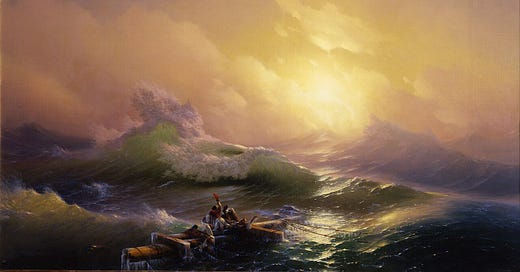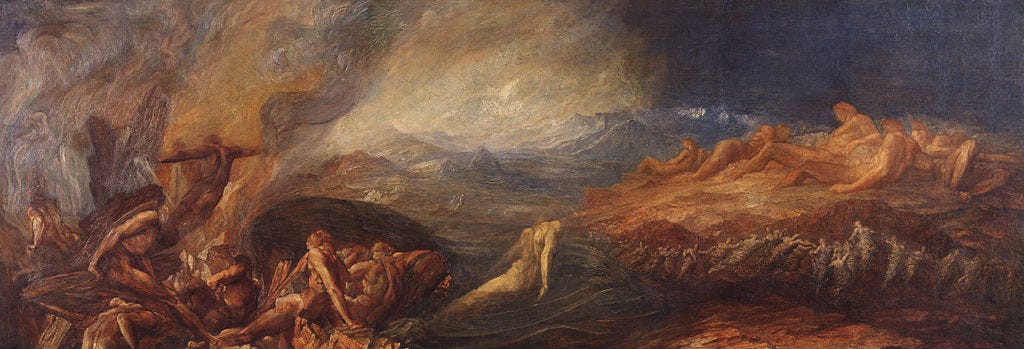Welcome to Cosmographia. This post is part of our series on Symbology. For the full map of posts, see here.
Where would we be without water? Water makes up 60% of our bodies and over 70% of the Earth’s surface. Life first began in deep water; no organism can survive without it. Water quenches, cleanses, and purifies. It has the strength to grind down the highest mountains, carve valleys through solid rock, yet at the same time it yields to the shape of any container, and allows passage to those that would swim through it. This duality is reflected in its symbolism: water appears in art, mythology, and literature as both a gentle life-giver, and a cataclysmic destroyer.
The ancients seem to have intuited the primordial importance of water, for it is so often invoked in cosmogonical myths. The Babylonian epic Enuma Elish describes a primeval mingling of freshwater (Apsu) and saltwater (Tiamat), from which the rest of the gods arise. Tiamat, the mighty sea-serpent goddess embodying the chaotic ocean, was slain by Marduk, her body becoming the heavens and earth. The ancient Egyptians, meanwhile, spoke of Nu, the ‘Watery One’, who was the personification of the primordial watery abyss that existed before creation and from which rose the creator sun god, Ra. The Greeks also sometimes referred to the original Khaos, from which the earliest gods were born, as celestial waters. In Genesis, “the Spirit of God was moving over the face of the waters” on the first day of creation, before he separated the waters to form sky and the land — here again water symbolises the undifferentiated matter from which the rest was made.
In Eastern traditions, the mythical Lake Anavatapta was said to lie at the centre of the world, its magical waters able to heal the fires that torment living beings, and where Queen Maya conceived the Buddha. The lake shared its name with a dragon that was said to live in its water, where it rested now having become a bodhisattva — a holy being on the path to Buddahood. Sometimes the lake was depicted in art as a whirlpool with four animal heads – a horse, a lion, an elephant, and an ox. From its quadruple helix flow four sacred rivers: the Indus, the Ganges, the Bramaputra, and the Sutlej.
Shesha was a celestial snake on which Vishnu reclines in the cosmic ocean. In another form, Vishnu appears as the avatar Matsya, a giant, golden fish, who saves the first man, Manu, from a great flood.


Speaking of floods, they appear an almost universal motif across world cultures. The oldest version of this story appears in the Epic of Gilgamesh, in which the gods send a flood to destroy humanity for making too much noise. Only Utnapishtim survives by building an ark. As a reward for his righteousness, after the flood subsides, Utnapishtim is granted wisdom and immortality. It seems incredibly likely that the Mesopotamian myth directly inspired the biblical account, in which Noah’s Flood cleanses the world of evil and corruption by destroying all of Cain’s progeny. In a sense, the water returns the earth to the primordial chaos and begins creation anew.
But flood myths appear in cultures outside of the Near East region too. The Greeks spoke of a great deluge sent by an angry Zeus, in which only Deucalion and his wife survive by hiding in a wooden chest. They repopulate the earth by casting stones which turn into new people. The Chinese Book of Documents (c. 1st millennium BC) relates the story of the Great Flood of Gun-Yu, supposed to have taken place around 2300-2200 BC, which lasted for two generations. Many heroic figures attempt to assuage the waters, and all failed, until Yu the Great, legendary king and founder of the Xia dynasty, dug canals to carry the water out to sea.
Over in the Americas, despite no contact with the Old World through which cultural diffusion may have occurred, many cultures have their own flood myths too. The Aztecs spoke of the flood that collapsed the sea into the water as the fourth sun (age) ended and the fifth began. Only Nata and Nena survived by riding out the storm in a hollowed-out tree. The North American Choctaw people told of a time of darkness, in which no light appeared for a great time on earth. Despairing they’d never see it again, suddenly one appeared on the horizon; their rejoicing was cut short when they realised it was not the sun but great mountains of waves coming to wash them away. The Inca’s supreme being, Con Tici Viracocha, first created a race of giants, but they proved unruly and he destroyed them in a flood before repopulating the world with humans.
With the Ket people of Siberia, the Yoruba of West Africa, the Polynesians of the Pacific all having their own flood myths too, it seems no geography is free of the motif. The Norse had one, so did the Koreans and the Zoroastrians. The similarities between these stories — divine punishment, a few righteous survivors in a wooden vessel — has led many an anthropologist and psychoanalyst casting about for an explanation. Some posit a long-forgotten flood in the deep recesses of prehistory, the myths all remnants of a distant cultural memory. People point to the melting ice of the Last Glacial Period (ending c. 11,700 years ago), or the controversial Black Sea deluge hypothesis, or a comet impact out at sea causing a gargantuan tsunami, as possible causes of this prehistoric flood.
Another idea is that the flood myth must date back to a time before the various groups and peoples of the world began to disperse around the globe. Proponents of this idea suggest that the myths we record now are simply percolations of the same primordial story, dating back to an early population bottleneck, such as the Out of Africa event. Jung and the psychoanalysts, meanwhile, contend the archetype is a reflection of certain universal, innate aspects of the human subconscious.
Personally, I think it can be explained by how common floods are across the world; we don’t need to invoke some primordial flood memory or the subterranean corners of the human mind to explain the ubiquity of the story — humans need to live close to water, whether a sea or a river. These bodies flood from time to time. The metaphor for a cleansing of the land or divine punishment is so obvious as to be self-explanatory.
It’s telling that the Egyptians had no flood myth of their own. The annual flooding of the Nile and the dispersal of its fertile silt was what made life along the narrow strip of water possible among the sands of the Sahara. In Egypt, the flood was the life-giver, not a cataclysm, hence no myth.








